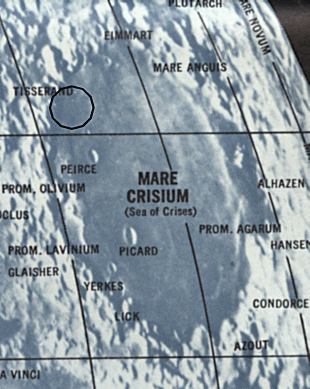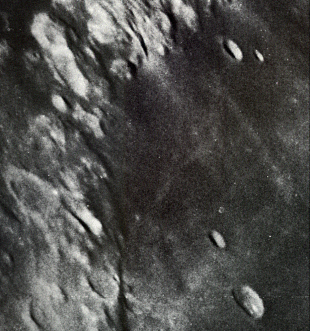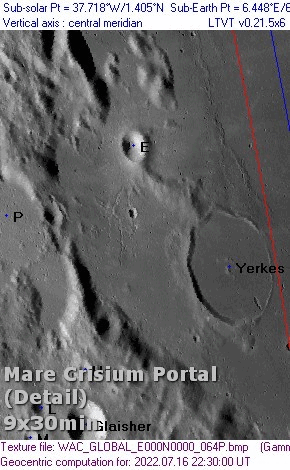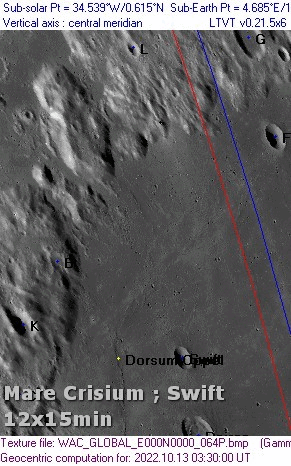The Mare Crisium Lunar Sunrise Ray
Initial Reports
Observer: Tony Donnangelo
Date/time of observation: 2002/3/02 ~03:30 UT
Location of site: Naylor Observatory, Lewisberry, PA.(40.26° N.,76.75° W.)
Site Elevation: 570 feet (174 meters)
Instrument: 17 Classical Cassegrain f/15
Magnification: 40mm Meade SWA (162x), 22mm Nagler (294x)
Moon was 89% illuminated. 17 days, 19:48.
Object: Mare Crisium. Rukl Chart #26.
Lunar Light Ray s Coordinates: 21.5°N., 53.0°E.
I observed a double lunar light ray in an area north of crater Swift, and what appeared to be east of the wrinkle ridge Oppel in Mare Crisium. The area of the crater south of Swift was illuminated; north of Swift was in shadow. The rays were both thin shafts of light and running parallel to each other. The rays may be able to be observed at an earlier time. I observed them on and off over the next hour. They would still be visible after that time. I hesitated to report it at this time because I felt the rays may be caused by the illumination of the top of two wrinkle ridges east of Oppel that are running parallel to each other in a northwest to southeast direction. I wanted to observe it again. Since my sighting that I mentioned to Dave Mitsky the following day, he informed me a few days later that he received a sighting report from Gary Honis and Bob Visgaitis (see next report). They also observed the double ray at approximately the same time. We contacted each other, and they don't think it was in the exact area of the wrinkled ridges but on the floor of Crisium. They posted a photograph of the sighting at this website. http://users.nni.com/ghaas/marerays.htm The rays aren't evident on the photograph. They are going to attempt photographing it again. We would appreciate any other observational reports on these rays.
Observers: Bob Visgaitis and Gary Honis
Observer location: GHAAS Observing Site Eckley, PA
Observer Coordinates: Longitude 75:51:30 West and Latitude 40:59:40 North
Ray Event Lunar Coordinates: 21 degrees North; 53 degrees East
Rukl Atlas of the Moon: Page 79; Section 26
Date of Event: Friday March 1, 2002
Time of event: Approximately 10:45 pm EST (10 minute window)
Sky Conditions: Clear
Seeing Conditions: Unsteady
Also of note is that the observation was made two days after Full Moon, when it was near perigee (close to Earth) and appeared 20 percent brighter and 9 percent wider than normal. During northern winter the Earth is also closer to the Sun.
Me and a fellow club observer, Bob Visgaitis were observing the Moon on March 1, 2002 with my 20
inch Starmaster Dobsonian Telescope when we observed what we believe to have been a double ray event in Mare Crisium. The two rays, which appeared as white spikes or streaks, were
very prominent against the background of a large black shadowed area. At first we just remarked how bright and straight these lines were as we shared views through the eyepiece, not
identifying them as crater rays at the time. Bob began to scan the GOTO telescope in the Mare Crisium area to observe other lunar features and after just a few minutes, we noticed that
the white rays were diminishing. I had been imaging with an Olympus C2000Z digital camera prior to our lunar observing so I mounted it on at the eyepiece and began to take closeup
images of the area where the rays were observed. To our dismay, the rays were not visible on the cameras LCD display upon imaging. With the camera removed, we observed the area
visually and the two rays were now gone! Later at home with some image processing, it was discovered that there were short and faint elongated glows, remnants of the two long rays
observed visually, in the first digital camera images taken. Images taken just a few minutes later showed no such glows.
Gary Honis
The Initial Predictions, Using Data in Original Reporting
Here we have two identical but independent observations at the same time. Tony Donnangelo observed the event on 2002/3/02 ~03:30 UT and Bob Visgaitis and Gary Honis observed the event on March 1, 2002 at 10:45 pm EST, which is 2002/3/02 3:45 UT. They both showed the approximate lunar coordinates as the same (within 1/2 degree). The database was set to show the position of the event at 21.0N and 53.0E for the purpose of generating predictions.
By running predictions using site coordinates, date and time of the event, it was determined that the event could be seen when the sun was 3.537 degrees setting, with an average colongitude of 164.753 degrees. This data was used to compute the predictions, found on the prediction page.
For Tony Donnangelo Observation:
Starting Date = 2002 / 1 / 1 U.T.
Site Longitude = 76.75 Latitude = 40.25 Elevation = 129 meters
Feature = CRISIUM
Longitude = 53° 0' Latitude = 21° 0'
Reproducing Lighting For: 2002 / 3 / 2 at 3 : 30 UT
Desired Solar altitude = 1.583° (Setting), Azimuth = 267.809°
Average Co-longitude = 125.305
In the time column, D=daylight, T=twilight
---- Moon's ----
Topocentric -- Earth's -- ------- Sun's -------
UT Date Time Alt° Semi-diam" long° lat° colong° lat° azim°
2002/ 3/ 2 3:30 16.02 997.64 4.43 -5.79 124.74 -1.48 267.81
for gary honis and bob visgaitis observation:
starting date = 2002 / 1 / 1 u.t.
site longitude = 75.85 latitude = 40.98 elevation = 129 meters
feature = crisium
longitude = 53° 0' latitude = 21° 0'
reproducing lighting for: 2002 / 3 / 2 at 3 : 45 ut
desired solar altitude = 1.465° (setting), azimuth = 267.855°
average co-longitude = 125.431
in the time column, d=daylight, t=twilight
---- moon's ----
topocentric -- earth's -- ------- sun's -------
ut date time alt° semi-diam" Long° Lat° Colong° Lat° Azim°
2002/ 3/ 2 3:45 18.85 998.76 4.44 -5.78 124.86 -1.48 267.85




Return to Home or use your browser back button





